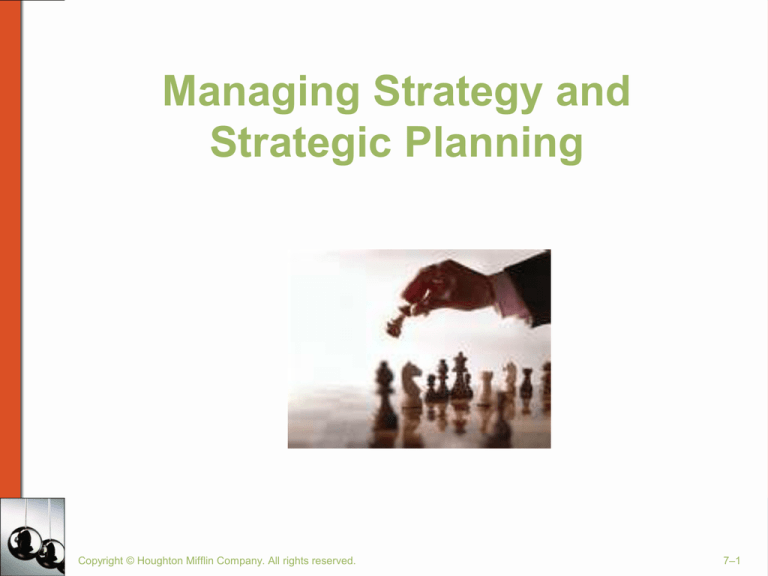
Managing Strategy and
Strategic Planning
Copyright © Houghton Mifflin Company. All rights reserved.
7–1
The Nature of Strategic
Management
• Strategy
– A comprehensive plan for accomplishing an
organization’s goals.
• Strategic Management
– A way of approaching business opportunities and
challenges aimed at formulating and implementing
effective strategies.
• Effective Strategies
– Strategies that promote a superior alignment
between the organization and its environment and
the achievement of its goals.
Copyright © Houghton Mifflin Company. All rights reserved.
8–2
Components of Strategy
• Distinctive Competence
– Something an organization
does exceptionally well.
• Scope
– Range of markets in which
an organization will
compete.
• Resource Deployment
– How an organization will
distribute its resources
across the areas in which it
competes.
Copyright © Houghton Mifflin Company. All rights reserved.
8–3
Types of Strategic Alternatives
• Business-Level Strategy
– The set of strategic alternatives that an
organization chooses from as it conducts business
in a particular industry or a particular market.
• Corporate-Level Strategy
– The set of strategic alternatives that an
organization chooses from as it manages its
operations simultaneously across several
industries and several markets.
Copyright © Houghton Mifflin Company. All rights reserved.
8–4
• Deliberate Strategy
– A plan, chosen and implemented to
support specific goals, that is the result of a
rational, systematic, and planned process
of strategy formulation and implementation.
• Emergent Strategy
– A pattern of action that develops over time
in the absence of goals or missions, or
despite goals and missions.
Copyright © Houghton Mifflin Company. All rights reserved.
7–5
SWOT ANALYSIS
Copyright © Houghton Mifflin Company. All rights reserved.
8–6
Formulating Business-Level
Strategies
Porter’s Generic
Strategies
Differentiation
strategy
Overall cost
leadership strategy
© 2010 South-Western, Cengage Learning, Inc. All rights reserved.
Focus
strategy
8–7
Business Level Strategies
Porter’s Generic Strategies
Differentiation – distinguish the company from competitors
through the quality of its products or services. If successfully
done, firm is able to charge more.
Examples: Rolex, Mercedes-Benz, Cross.
Overall Cost Leadership – gain a competitive advantage by
reducing the firm’s costs below the costs of competing firms.
Can sell products at low prices and still make a profit.
Examples: Timex, Hyundai, Bic.
Focus – concentrates on a specific regional market, product
line, or group of buyers. Either differentiation focus or
overall cost leadership focus.
Examples: Tag Heuer, Fiat, Alfa Romeo
Copyright © Houghton Mifflin Company. All rights reserved.
8–8
Formulating Corporate Level
Strategies
• Strategic Business Units
– Each business or group of businesses within
an organization is engaged in serving the
same markets, customers, or products.
• Diversification
– The number of businesses an organization is
engaged in and the extent to which these
businesses are related to one another
Copyright © Houghton Mifflin Company. All rights reserved.
7–9
Corporate-Level Strategies
Strategic Choices
Single-product
strategy
(simplicity)
Related
diversification
(synergy)
© 2010 South-Western, Cengage Learning, Inc. All rights reserved.
Unrelated
diversification
(risk/return)
8–10
Corporate-Level Strategies
Single-Product Strategy
– An organization manufactures one product or service
and sells it in a single geographic market.
Example: WD40
• Related Diversification
– A strategy in which an organization operates in
several different businesses, industries, or markets
that are somehow linked.
– Avoids the disadvantages and risks of a singleproduct strategy.
Examples: Procter & Gamble - common distribution
Disney – brand name
Boeing – common technology
8–11
Advantages of Related
Diversification
– Reduces an organization’s dependence on any
one of its business activities and thus reduces
economic risk.
– Reduces overhead costs associated with
managing any one business through economies of
scale and economies of scope.
– Allows an organization to exploit its strengths and
capabilities in more than one business.
– Synergy exists among a set of businesses when
the businesses’ value together is greater than their
economic value separately.
Copyright © Houghton Mifflin Company. All rights reserved.
8–12
Unrelated Diversification
An organization operates multiple businesses that are not
logically associated with one another.
Example: General Electric
– Advantages
• Stable of performance over time due to business cycle
differences among the multiple businesses.
• Allocation of resources to areas with the highest return
potentials to maximize corporate performance.
– Disadvantages
• Poor performance due to the complexity of managing a
diversity of businesses.
• Failing to exploit key synergies puts the firm at a
competitive disadvantage to firms with related
diversification strategies.
Copyright © Houghton Mifflin Company. All rights reserved.
8–13
Becoming a Diversified Firm
Diversification Alternatives
Development of
new products
Vertical integration
© 2010 South-Western, Cengage Learning, Inc. All rights reserved.
Merger with
another firm
Acquisition of
another firm
8–14
Becoming a Diversified Firm
Replacement of Suppliers And Customers
– Backward vertical integration
• Beginning a business that furnishes resources previously
handled by a supplier.
– Forward vertical integration
• Beginning a business previously handled by an intermediary
and selling more directly to customers.
Purposes of Mergers and Acquisitions
– To diversify through vertical integration.
– To acquire complementary products or services linked by a
common technology and common customers.
– To create or exploit synergies that reduce the combined
organizations’ costs of doing business to increase revenues.
Copyright © Houghton Mifflin Company. All rights reserved.
7–15
Managing Diversification
Portfolio management techniques
• Methods that diversified organizations use to make
decisions about what businesses to engage in and how
to manage these multiple businesses to maximize
corporate performance.
Two important portfolio management techniques
• The BCG Matrix
– A method of evaluating businesses relative to the growth rate of
their market and the organization’s share of the market.
• The GE Business Screen
– A method of evaluating business in a diversified portfolio along
two dimensions, each of which contains multiple factors:
» Industry attractiveness.
» Competitive position (strength) of each firm in the portfolio.
Copyright © Houghton Mifflin Company. All rights reserved.
8–16
The BCG Matrix
Dogs have small
market shares and no
growth prospects.
Cash cows have large
shares of mature
markets.
Question marks have
small market shares in
quickly growing
markets.
Stars have large
shares of rapidly
growing markets.
Source: Perspectives, No. 66, “The Product Portfolio.” Adapted by permission from The Boston Consulting Group, Inc., 1970.
Copyright © Houghton Mifflin Company. All rights reserved.
8–17
The GE Business Screen
Copyright © Houghton Mifflin Company. All rights reserved.
8–18
Contingency Planning
Alternative courses of action to be taken if an intended plan is
unexpectedly disrupted or rendered inappropriate
Crisis Management
Set of procedures the organization will use in the event of a
disaster or other unexpected calamity
Copyright © Houghton Mifflin Company. All rights reserved.
7–19








